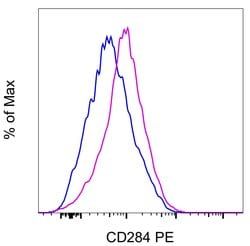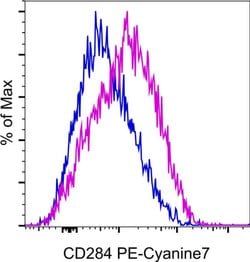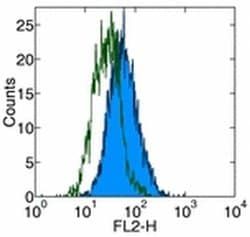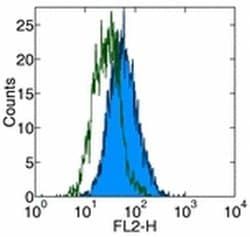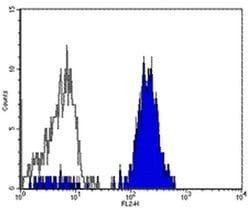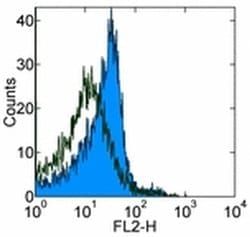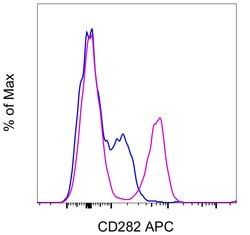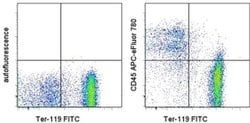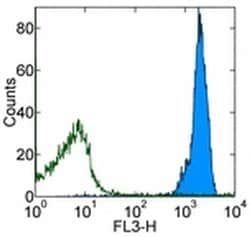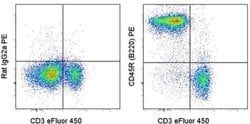50-112-9641
CD284 (TLR4) Monoclonal Antibody (HTA125), Functional Grade, eBioscience™, Invitrogen™
Manufacturer: Invitrogen
Select a Size
| Pack Size | SKU | Availability | Price |
|---|---|---|---|
| Each of 1 | 50-112-9641-Each-of-1 | In Stock | ₹ 24,564.00 |
50-112-9641 - Each of 1
In Stock
Quantity
1
Base Price: ₹ 24,564.00
GST (18%): ₹ 4,421.52
Total Price: ₹ 28,985.52
Antigen
CD284 (TLR4)
Classification
Monoclonal
Concentration
1 mg/mL
Formulation
PBS with no preservative; pH 7.2
Gene Accession No.
O00206
Gene Symbols
TLR4
Purification Method
Affinity chromatography
Regulatory Status
RUO
Gene ID (Entrez)
7099
Content And Storage
4° C
Form
Liquid
Applications
Flow Cytometry, Functional Assay, Neutralization
Clone
HTA125
Conjugate
Functional Grade
Gene
TLR4
Gene Alias
ARMD10; CD284; EGK_07381; homolog of Drosophila toll; hToll; lipopolysaccharide response; Lps; Ly87; Ran/M1; Rasl2-8; Tlr4; TLR-4; TOLL; toll like receptor 4; toll/interleukin-l receptor (TIR) domain; toll4; toll-like receptor 4; toll-like receptor 4 immunity-related protein; Toll-like receptor 4-like protein; Toll-like receptor4 protein
Host Species
Mouse
Quantity
100 μg
Primary or Secondary
Primary
Target Species
Human
Product Type
Antibody
Isotype
IgG2a κ
Description
- Description: The HTA125 monoclonal antibody reacts with human Toll-like receptor 4 (TLR4)
- So far, at least ten members of the Toll family have been identified in humans
- This family of type I transmembrane proteins is characterized by an extracellular domain with leucine-rich repeats and a cytoplasmic domain with homology to the type I IL-1 receptor
- Two of these receptors, TLR2 and TLR4, are pattern recognition receptors and signaling molecules in response to bacterial lipoproteins and have been implicated in innate immunity and inflammation
- TLR4 physically associates with another molecule called MD-2, and together with CD14, this complex is responsible for LPS recognition and signaling
- TLR4 is expressed by peripheral blood monocytes
- HTA125 has been reported to immunoprecipitate human TLR4 (∽100 kDa) from transfected cells
- Most TLR cell surface expression, especially TLR1 and TLR4, occurs at low levels on monocytes and at even lower levels on other cell types including granulocytes and immature dendritic cells (iDC)
- Furthermore, a relatively high degree of variability in TLR surface expression has been reported among normal donors
- Applications Reported: The HTA125 antibody has been reported for use in flow cytometric analysis
- It has also been reported in blocking of LPS-induced cytokine production
- TLR4 is member of the Toll like receptor (TLR) family which plays a fundamental role in pathogen recognition and activation of innate immunity
- TLRs are highly conserved from Drosophila to humans and share structural and functional similarities
- This receptor is most abundantly expressed in placenta, and in myelomonocytic subpopulation of the leukocytes
- Mammalian cells respond to LPS by activating TLR4
- TLR4 belongs to the multi-protein complex of lipopolysaccharide (LPS) receptor, containing CD14, LY96 and TLR4, and is involved in signal transduction events induced by lipopolysaccharide (LPS) found in most gram-negative bacteria
- TLR4 aids in the recognition of pathogen-associated molecular patterns (PAMPs) that are expressed on infectious agents, and mediate the production of cytokines necessary for the development of effective immunity
- The various TLRs exhibit different patterns of expression
- Mutations in the TLR4 gene have been associated with differences in LPS responsiveness
- Also, several transcript variants of the TLR4 gene have been found, but the protein coding potential of most of them is uncertain
- TLR4 is expressed by peripheral blood monocytes and a small population of B-cells and is also expressed in human placenta
- Studies with TLR4-deficient mice indicate that the main ligand for TLR is lipopolysaccharide
- Consequently, these mice also showed increased susceptibility to Gram-negative sepsis.
Compare Similar Items
Show Difference
Antigen: CD284 (TLR4)
Classification: Monoclonal
Concentration: 1 mg/mL
Formulation: PBS with no preservative; pH 7.2
Gene Accession No.: O00206
Gene Symbols: TLR4
Purification Method: Affinity chromatography
Regulatory Status: RUO
Gene ID (Entrez): 7099
Content And Storage: 4° C
Form: Liquid
Applications: Flow Cytometry, Functional Assay, Neutralization
Clone: HTA125
Conjugate: Functional Grade
Gene: TLR4
Gene Alias: ARMD10; CD284; EGK_07381; homolog of Drosophila toll; hToll; lipopolysaccharide response; Lps; Ly87; Ran/M1; Rasl2-8; Tlr4; TLR-4; TOLL; toll like receptor 4; toll/interleukin-l receptor (TIR) domain; toll4; toll-like receptor 4; toll-like receptor 4 immunity-related protein; Toll-like receptor 4-like protein; Toll-like receptor4 protein
Host Species: Mouse
Quantity: 100 μg
Primary or Secondary: Primary
Target Species: Human
Product Type: Antibody
Isotype: IgG2a κ
Antigen:
CD284 (TLR4)
Classification:
Monoclonal
Concentration:
1 mg/mL
Formulation:
PBS with no preservative; pH 7.2
Gene Accession No.:
O00206
Gene Symbols:
TLR4
Purification Method:
Affinity chromatography
Regulatory Status:
RUO
Gene ID (Entrez):
7099
Content And Storage:
4° C
Form:
Liquid
Applications:
Flow Cytometry, Functional Assay, Neutralization
Clone:
HTA125
Conjugate:
Functional Grade
Gene:
TLR4
Gene Alias:
ARMD10; CD284; EGK_07381; homolog of Drosophila toll; hToll; lipopolysaccharide response; Lps; Ly87; Ran/M1; Rasl2-8; Tlr4; TLR-4; TOLL; toll like receptor 4; toll/interleukin-l receptor (TIR) domain; toll4; toll-like receptor 4; toll-like receptor 4 immunity-related protein; Toll-like receptor 4-like protein; Toll-like receptor4 protein
Host Species:
Mouse
Quantity:
100 μg
Primary or Secondary:
Primary
Target Species:
Human
Product Type:
Antibody
Isotype:
IgG2a κ
Antigen: CD45
Classification: Monoclonal
Concentration: 0.2 mg/mL
Formulation: PBS with 0.09% sodium azide; pH 7.2
Gene Accession No.: P06800
Gene Symbols: PTPRC
Purification Method: Affinity chromatography
Regulatory Status: RUO
Gene ID (Entrez): 19264
Content And Storage: 4° C, store in dark, DO NOT FREEZE!
Form: Liquid
Applications: Flow Cytometry
Clone: 30-F11
Conjugate: APC-eFluor 780
Gene: PTPRC
Gene Alias: B220; cd45; CD45 antigen; CD45 antigen isoform 1 precursor; CD45 antigen isoform 2 precursor; CD45 antigen isoform 3 precursor; CD45 antigen isoform 4 precursor; CD45 antigen isoform 5 precursor; CD45 antigen isoform 6 precursor; CD45R; GP180; Lca; L-CA; leucocyte common antigen; leukocyte common antigen; leukocyte common antigen A; leukocyte common antigen B; leukocyte common antigen, CD45; loc; LOW QUALITY PROTEIN: receptor-type tyrosine-protein phosphatase C; LY5; Ly-5; lymphocyte antigen 5; lymphocyte common antigen; Lyt-4; membrane tyrosine phosphatase; protein tyrosine phosphatase lambda; protein tyrosine phosphatase receptor type C; protein tyrosine phosphatase, receptor type C; protein tyrosine phosphatase, receptor type, C; protein tyrosine phosphatase, receptor type, c polypeptide; Protein tyrosine phosphatase, receptor-type, c polypeptide; protein tyrosine phosphatase; alternatively spliced; Ptprc; Receptor-type tyrosine-protein phosphatase C; RT7; T200; T200 glycoprotein; T200 leukocyte common antigen; T220 and B220
Host Species: Rat
Quantity: 100 μg
Primary or Secondary: Primary
Target Species: Mouse
Product Type: Antibody
Isotype: IgG2b κ
Antigen:
CD45
Classification:
Monoclonal
Concentration:
0.2 mg/mL
Formulation:
PBS with 0.09% sodium azide; pH 7.2
Gene Accession No.:
P06800
Gene Symbols:
PTPRC
Purification Method:
Affinity chromatography
Regulatory Status:
RUO
Gene ID (Entrez):
19264
Content And Storage:
4° C, store in dark, DO NOT FREEZE!
Form:
Liquid
Applications:
Flow Cytometry
Clone:
30-F11
Conjugate:
APC-eFluor 780
Gene:
PTPRC
Gene Alias:
B220; cd45; CD45 antigen; CD45 antigen isoform 1 precursor; CD45 antigen isoform 2 precursor; CD45 antigen isoform 3 precursor; CD45 antigen isoform 4 precursor; CD45 antigen isoform 5 precursor; CD45 antigen isoform 6 precursor; CD45R; GP180; Lca; L-CA; leucocyte common antigen; leukocyte common antigen; leukocyte common antigen A; leukocyte common antigen B; leukocyte common antigen, CD45; loc; LOW QUALITY PROTEIN: receptor-type tyrosine-protein phosphatase C; LY5; Ly-5; lymphocyte antigen 5; lymphocyte common antigen; Lyt-4; membrane tyrosine phosphatase; protein tyrosine phosphatase lambda; protein tyrosine phosphatase receptor type C; protein tyrosine phosphatase, receptor type C; protein tyrosine phosphatase, receptor type, C; protein tyrosine phosphatase, receptor type, c polypeptide; Protein tyrosine phosphatase, receptor-type, c polypeptide; protein tyrosine phosphatase; alternatively spliced; Ptprc; Receptor-type tyrosine-protein phosphatase C; RT7; T200; T200 glycoprotein; T200 leukocyte common antigen; T220 and B220
Host Species:
Rat
Quantity:
100 μg
Primary or Secondary:
Primary
Target Species:
Mouse
Product Type:
Antibody
Isotype:
IgG2b κ
Antigen: CD45
Classification: Monoclonal
Concentration: 0.2 mg/mL
Formulation: PBS with 0.09% sodium azide; pH 7.2
Gene Accession No.: P06800
Gene Symbols: PTPRC
Purification Method: Affinity chromatography
Regulatory Status: RUO
Gene ID (Entrez): 19264
Content And Storage: 4° C, store in dark, DO NOT FREEZE!
Form: Liquid
Applications: Flow Cytometry
Clone: 30-F11
Conjugate: PE-Cyanine7
Gene: PTPRC
Gene Alias: B220; cd45; CD45 antigen; CD45 antigen isoform 1 precursor; CD45 antigen isoform 2 precursor; CD45 antigen isoform 3 precursor; CD45 antigen isoform 4 precursor; CD45 antigen isoform 5 precursor; CD45 antigen isoform 6 precursor; CD45R; GP180; Lca; L-CA; leucocyte common antigen; leukocyte common antigen; leukocyte common antigen A; leukocyte common antigen B; leukocyte common antigen, CD45; loc; LOW QUALITY PROTEIN: receptor-type tyrosine-protein phosphatase C; LY5; Ly-5; lymphocyte antigen 5; lymphocyte common antigen; Lyt-4; membrane tyrosine phosphatase; protein tyrosine phosphatase lambda; protein tyrosine phosphatase receptor type C; protein tyrosine phosphatase, receptor type C; protein tyrosine phosphatase, receptor type, C; protein tyrosine phosphatase, receptor type, c polypeptide; Protein tyrosine phosphatase, receptor-type, c polypeptide; protein tyrosine phosphatase; alternatively spliced; Ptprc; Receptor-type tyrosine-protein phosphatase C; RT7; T200; T200 glycoprotein; T200 leukocyte common antigen; T220 and B220
Host Species: Rat
Quantity: 100 μg
Primary or Secondary: Primary
Target Species: Mouse
Product Type: Antibody
Isotype: IgG2b κ
Antigen:
CD45
Classification:
Monoclonal
Concentration:
0.2 mg/mL
Formulation:
PBS with 0.09% sodium azide; pH 7.2
Gene Accession No.:
P06800
Gene Symbols:
PTPRC
Purification Method:
Affinity chromatography
Regulatory Status:
RUO
Gene ID (Entrez):
19264
Content And Storage:
4° C, store in dark, DO NOT FREEZE!
Form:
Liquid
Applications:
Flow Cytometry
Clone:
30-F11
Conjugate:
PE-Cyanine7
Gene:
PTPRC
Gene Alias:
B220; cd45; CD45 antigen; CD45 antigen isoform 1 precursor; CD45 antigen isoform 2 precursor; CD45 antigen isoform 3 precursor; CD45 antigen isoform 4 precursor; CD45 antigen isoform 5 precursor; CD45 antigen isoform 6 precursor; CD45R; GP180; Lca; L-CA; leucocyte common antigen; leukocyte common antigen; leukocyte common antigen A; leukocyte common antigen B; leukocyte common antigen, CD45; loc; LOW QUALITY PROTEIN: receptor-type tyrosine-protein phosphatase C; LY5; Ly-5; lymphocyte antigen 5; lymphocyte common antigen; Lyt-4; membrane tyrosine phosphatase; protein tyrosine phosphatase lambda; protein tyrosine phosphatase receptor type C; protein tyrosine phosphatase, receptor type C; protein tyrosine phosphatase, receptor type, C; protein tyrosine phosphatase, receptor type, c polypeptide; Protein tyrosine phosphatase, receptor-type, c polypeptide; protein tyrosine phosphatase; alternatively spliced; Ptprc; Receptor-type tyrosine-protein phosphatase C; RT7; T200; T200 glycoprotein; T200 leukocyte common antigen; T220 and B220
Host Species:
Rat
Quantity:
100 μg
Primary or Secondary:
Primary
Target Species:
Mouse
Product Type:
Antibody
Isotype:
IgG2b κ
Antigen: CD45R (B220)
Classification: Monoclonal
Concentration: 0.2 mg/mL
Formulation: PBS with 0.09% sodium azide; pH 7.2
Gene Accession No.: P06800, P08575
Gene Symbols: PTPRC
Purification Method: Affinity chromatography
Regulatory Status: RUO
Gene ID (Entrez): 19264, 5788
Content And Storage: 4° C, store in dark, DO NOT FREEZE!
Form: Liquid
Applications: Flow Cytometry
Clone: RA3-6B2
Conjugate: PE
Gene: PTPRC
Gene Alias: B220; Cd45; CD45 antigen; CD45R; GP180; Lca; L-CA; leucocyte common antigen; leukocyte common antigen; leukocyte common antigen A; leukocyte common antigen B; loc; LY5; Ly-5; Lymphocyte antigen 5; lymphocyte common antigen; Lyt-4; membrane tyrosine phosphatase; protein tyrosine phosphatase receptor type C; protein tyrosine phosphatase, receptor type C; protein tyrosine phosphatase, receptor type, C; protein tyrosine phosphatase, receptor type, c polypeptide; Protein tyrosine phosphatase, receptor-type, c polypeptide; Ptprc; Receptor-type tyrosine-protein phosphatase C; RT7; T200; T200 glycoprotein; T200 leukocyte common antigen
Host Species: Rat
Quantity: 50 μg
Primary or Secondary: Primary
Target Species: Human, Mouse
Product Type: Antibody
Isotype: IgG2a κ
Antigen:
CD45R (B220)
Classification:
Monoclonal
Concentration:
0.2 mg/mL
Formulation:
PBS with 0.09% sodium azide; pH 7.2
Gene Accession No.:
P06800, P08575
Gene Symbols:
PTPRC
Purification Method:
Affinity chromatography
Regulatory Status:
RUO
Gene ID (Entrez):
19264, 5788
Content And Storage:
4° C, store in dark, DO NOT FREEZE!
Form:
Liquid
Applications:
Flow Cytometry
Clone:
RA3-6B2
Conjugate:
PE
Gene:
PTPRC
Gene Alias:
B220; Cd45; CD45 antigen; CD45R; GP180; Lca; L-CA; leucocyte common antigen; leukocyte common antigen; leukocyte common antigen A; leukocyte common antigen B; loc; LY5; Ly-5; Lymphocyte antigen 5; lymphocyte common antigen; Lyt-4; membrane tyrosine phosphatase; protein tyrosine phosphatase receptor type C; protein tyrosine phosphatase, receptor type C; protein tyrosine phosphatase, receptor type, C; protein tyrosine phosphatase, receptor type, c polypeptide; Protein tyrosine phosphatase, receptor-type, c polypeptide; Ptprc; Receptor-type tyrosine-protein phosphatase C; RT7; T200; T200 glycoprotein; T200 leukocyte common antigen
Host Species:
Rat
Quantity:
50 μg
Primary or Secondary:
Primary
Target Species:
Human, Mouse
Product Type:
Antibody
Isotype:
IgG2a κ
